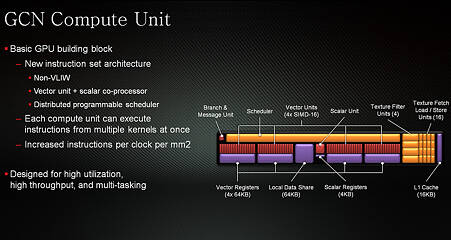 301
301
AMD Radeon HD 7970 3 GB Review
Packaging & Contents »Architecture
Tahiti, named after the lovely Tahiti islands of French Polynesia in the South Pacific, is AMD's new high-performance GPU. It succeeds Cayman, the chip powering the Radeon HD 6900 series and the dual-GPU HD 6990. Tahiti is built on TSMC's brand new 28 nanometer silicon fabrication process. In a nutshell, it retains the tried and trusted component hierarchy of its predecessors, but with major changes in the math processing SIMD machinery, and raster operations processors (ROPs) de-linked from the memory bus width.
With Tahiti, AMD is introducing the biggest revamp in the way its GPUs crunch numbers, since the Radeon HD 2000. Back then AMD adopted the "Graphics Parallel Core" compute architecture which uses clumps of super-scalar processors that work out "very long instruction words" (VLIW). The older version of Graphics Parallel Core used sets of four simple stream processors with one complex stream processor (that has more capabilities), along with branch units and general purpose registers. This made up with VLIW5 design. With Radeon HD 6900 "Cayman" GPU, AMD implemented a newer design that used groups of four equipotent stream processors, making up the more advanced VLIW4 design.
As mentioned earlier, for the most part, the GPU's component hierarchy is the same, except that its number-crunching parts have undergone, in AMD's words, a revolutionary change. VLIW5 to VLIW4 was evolutionary, in comparison. With Tahiti, AMD replaced its VLIW stream processor clusters with GCN (Graphics Core Next) compute units. Each GCN compute unit is a super-scalar processor that combines scalar and vector elements that follow a new non-VLIW instruction-set architecture, and utilizes an improved layout of shared and dedicated components. To the end-user, this architecture translates into higher performance per millimeter square of GPU die area. Smaller the GPU die, cheaper it is to produce, and sometimes, lower its power draw.
Graphics CoreNext also brings with it what AMD refers to as its 9th Generation Tessellation unit. Tahiti packs two geometry engines, and with it, two independent tessellation units. These units take advantage of larger parameter caches, new off-chip buffering capabilities, and new vertex reuse instructions to deliver a whopping four times tessellation performance improvement over the previous generation, at least on paper.
In a nutshell, the Tahiti die measures 365 mm², holding 4.31 billion transistors. It is built on the 28 nm TSMC process. It has 32 GCN compute units and 2048 stream processors in all. There are 128 texture memory units (TMUs), and 32 raster operation processors (ROPs). Despite having a 384-bit wide memory interface, the raster operations processor (ROP) count didn't increase proportionately to 48, as expected. This is because AMD reconfigured the way ROPs interact with the rest of the GPU, and hence retained its conventional ROP count of 32. The 384-bit wide memory interface combined with 5.5 GT/s GDDR5 memory chips sums up to a 264 GB/s memory bandwidth. Since it uses twelve 2 Gbit memory chips, it ends up with 3 GB of total memory on board.
Apr 18th, 2025 09:11 EDT
change timezone
Latest GPU Drivers
New Forum Posts
- RX 9000 series GPU Owners Club (380)
- Overclocking an Intel I7-6700 (Non K) on a Lenovo 30L Gaming PC (11)
- Subsystem Id of my Asus Strix RTX 4090 OC / Random GPU detection problem (9)
- DTS DCH Driver for Realtek HDA [DTS:X APO4 + DTS Interactive] (2145)
- 5070 Ti power limit questions (50)
- Can anyone else replicate this crash on the 9070? (43)
- The TPU UK Clubhouse (26142)
- TPU's Rosetta Milestones and Daily Pie Thread (2280)
- Graphics cards for 1440p OLED - QD-OLED monitors. (12)
- Have you got pie today? (16670)
Popular Reviews
- ASUS GeForce RTX 5060 Ti TUF OC 16 GB Review
- NVIDIA GeForce RTX 5060 Ti PCI-Express x8 Scaling
- G.SKILL Trident Z5 NEO RGB DDR5-6000 32 GB CL26 Review - AMD EXPO
- Palit GeForce RTX 5060 Ti Infinity 3 16 GB Review
- ASUS GeForce RTX 5060 Ti Prime OC 16 GB Review
- Zotac GeForce RTX 5060 Ti AMP 16 GB Review
- MSI GeForce RTX 5060 Ti Gaming OC 16 GB Review
- Teevolution Terra Pro Review
- MSI GeForce RTX 5060 Ti Gaming Trio OC 16 GB Review
- ASUS GeForce RTX 5080 TUF OC Review
Controversial News Posts
- NVIDIA GeForce RTX 5060 Ti 16 GB SKU Likely Launching at $499, According to Supply Chain Leak (182)
- NVIDIA Sends MSRP Numbers to Partners: GeForce RTX 5060 Ti 8 GB at $379, RTX 5060 Ti 16 GB at $429 (127)
- Nintendo Confirms That Switch 2 Joy-Cons Will Not Utilize Hall Effect Stick Technology (105)
- Over 200,000 Sold Radeon RX 9070 and RX 9070 XT GPUs? AMD Says No Number was Given (100)
- Nintendo Switch 2 Launches June 5 at $449.99 with New Hardware and Games (99)
- NVIDIA Launches GeForce RTX 5060 Series, Beginning with RTX 5060 Ti This Week (97)
- Sony Increases the PS5 Pricing in EMEA and ANZ by Around 25 Percent (85)
- NVIDIA PhysX and Flow Made Fully Open-Source (77)






